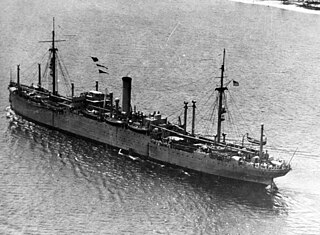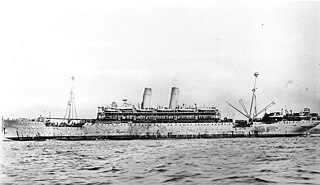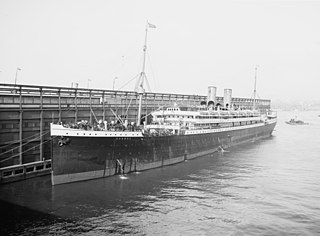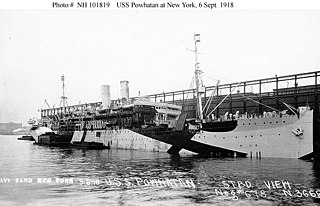
USS Pocahontas (SP-3044) was a transport ship for the United States Navy during World War I. She was originally SS Prinzess Irene, a Barbarossa-class ocean liner built in 1899 by AG Vulcan Stettin of Stettin, Germany, for the North German Lloyd line.
Aktien-Gesellschaft Vulcan Stettin was a German shipbuilding and locomotive building company. Founded in 1851, it was located near the former eastern German city of Stettin, today Polish Szczecin. Because of the limited facilities in Stettin, in 1907 an additional yard was built in Hamburg. The now named Vulcan-Werke Hamburg und Stettin Actiengesellschaft constructed some of the most famous civilian German ships and it played a significant role in both World Wars, building warships for the Kaiserliche Marine and the Kriegsmarine later.

SS Deutschland was a passenger liner built in Stettin and launched in 1900 by the Hamburg America Line of Germany. The rival North German Lloyd line had launched Germany's first four funnel liner, Kaiser Wilhelm der Grosse in 1897, and SS Deutschland was built by Hamburg America as Germany's second four-funnel liner in order to compete.

SS Saale was an ocean liner for North German Lloyd in the late 19th century, which was severely damaged in the 1900 Hoboken Docks Fire. On 30 June 1900, Saale was moored at the North German Lloyd piers in Hoboken, New Jersey, preparing to depart on a transatlantic crossing when some cotton on a nearby pier caught on fire and spread to the ship. Saale and several other ships were soon engulfed in flames; 99 passengers and crew on Saale were killed in the fire and subsequent sinking.

USS DeKalb (ID-3010) was the German mail ship Prinz Eitel Friedrich that served during the early part of the First World War as an auxiliary cruiser (Hilfkreuzer) in the Imperial German Navy and later after the US entry into the war, as a US Navy troop ship. Post war she returned to civilian service as the US transatlantic liner SS Mount Clay.

USS Rappahannock (AF-6) was a Rappahannock-class stores ship acquired by the U.S. Navy for use in World War I. She served in the dangerous North Atlantic Ocean, delivering animals, such as horses and steers on-the-hoof, to American Expeditionary Force troops in Europe.

USS Aeolus (ID-3005), sometimes also spelled Æolus, was a United States Navy transport ship during World War I. She was formerly the North German Lloyd liner SS Grosser Kurfürst, also spelled Großer Kurfürst, launched in 1899 that sailed regularly between Bremen and New York. At the outset of World War I the ship was interned by the United States and, when the U.S. entered the conflict in 1917, was seized and converted to a troop transport.

SS Friedrich der Grosse was a Norddeutscher Lloyd liner built in 1896 which sailed Atlantic routes from Germany and sometimes Italy to the United States and on the post run to Australia. At the outset of World War I the ship was interned by the U.S. and, when that country entered the conflict in 1917, was seized and converted to a troop transport, becoming USS Huron (ID-1408).
SS Prinz Eitel Friedrich may refer to one of the following ships named for Prince Eitel Friedrich of Prussia:

USS Princess Matoika (ID-2290) was a transport ship for the United States Navy during World War I. Before the war, she was a Barbarossa-class ocean liner that sailed as SS Kiautschou for the Hamburg America Line and as SS Princess Alice for North German Lloyd. After her World War I Navy service ended, she served as the United States Army transport ship USAT Princess Matoika. In post-war civilian service she was SS Princess Matoika until 1922, SS President Arthur until 1927, and SS City of Honolulu until she was scrapped in 1933.
SS Princess Alice may refer to:

USS Lenape (ID-2700) was a troop transport for the United States Navy in 1918, during World War I. She was launched in 1912 as SS Lenape, a passenger steamer for the Clyde Line. After the entry of the United States into World War I in 1917, she was chartered by the United States Army as transport USAT Lenape. After her Navy service ended in October 1918, she was returned to the Army.

Mutiny of the Matoika is the common name for the events in July 1920 involving a large portion of the Olympic team of the United States while on board the U.S. Army transport ship Princess Matoika, headed to Antwerp for the 1920 Summer Olympics. Princess Matoika was a last-minute substitute for another ship and, according to the athletes, did not have adequate accommodations or training facilities on board. Near the end of the voyage, the athletes published a list of grievances and demands and distributed copies of the document to the United States Secretary of War, the American Olympic Committee (AOC) members, and the press. The incident received wide coverage in American newspapers at the time and was still being discussed in the popular press years later. The event was not a mutiny in the traditional sense, but has been called that since the mid-1930s.

SS Prinz Friedrich Wilhelm was an ocean liner for North German Lloyd (NDL) from her launch in 1907 until the end of World War I. After the war, she briefly served as USS Prinz Friedrich Wilhelm (ID-4063) for the United States Navy returning American troops from France. The vessel was first chartered—and later purchased outright—by Canadian Pacific Steamships (CP) and operated under the names Empress of China, Empress of India, Montlaurier, Monteith, and Montnairn. She was scrapped in 1929.

USS Rijndam (ID-2505) was a transport for the United States Navy during World War I. Both before and after her Navy service she was known as SS Rijndam or Ryndam as an ocean liner for the Holland America Line.
SS Caserta was an Italian ocean liner named for the city of Caserta in the Campania region of Italy. She was previously known as SS Maritzburg and SS Mendoza, and was later renamed SS Venezuela. Launched in 1904 as Maritzburg for the Bucknall Line, the ship was sold to Lloyd Italiano in 1905 and renamed Mendoza. Renamed Caserta in 1914, she was placed under the Navigazione Generale Italiana banner in 1918. During World War I she was employed as a troopship carrying United States troops to France as part of the United States Navy Cruiser and Transport Force. In 1923, she was renamed Venezuela and transferred to La Veloce for South American service, but reverted to NGI control in 1924. She was scrapped in 1928.

The Barbarossa class was a class of ocean liners of North German Lloyd and the Hamburg America Line of the German Empire. Of the ten ships built between 1896 and 1902, six were built by AG Vulcan Stettin, three were built by Blohm & Voss, and one was built by Schichau-Werke; all were built in Germany. They averaged 11,000 gross register tons (GRT) and featured twin screw propellers driven by quadruple-expansion steam engines.

USS Powhatan (ID–3013) was a transport ship for the United States Navy during World War I. She was originally the SS Hamburg, a Barbarossa-class ocean liner built in 1899 by Aktiengesellschaft Vulkan of Stettin, Germany, for the Hamburg America Line. At the outset of World War I the ship was interned by the United States.

The first RMS Saxonia was a passenger ship of the British Cunard Line. Between 1900 and 1925, Saxonia operated on North Atlantic and Mediterranean passenger routes, and she saw military service during World War I (1914–1918).

The Kaiser-class ocean liners or Kaiserklasse refer to four transatlantic ocean liners of the Norddeutscher Lloyd, a German shipping company. Built by the AG Vulcan Stettin between 1897 and 1907, these ships were designed to be among the largest and best appointed liners of their day. These four ships, two of which held the prestigious Blue Riband, were known as the "four flyers" and all proved to be popular with wealthy transatlantic travellers. They also took great advantage of the masses of immigrants who wished to leave Europe.














